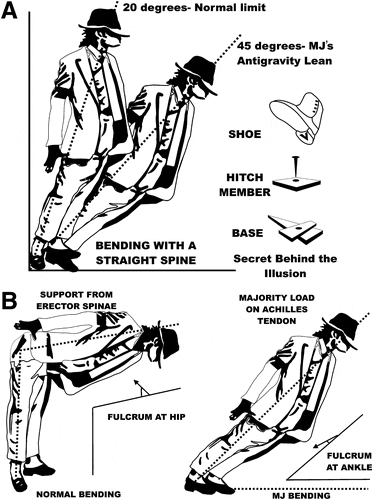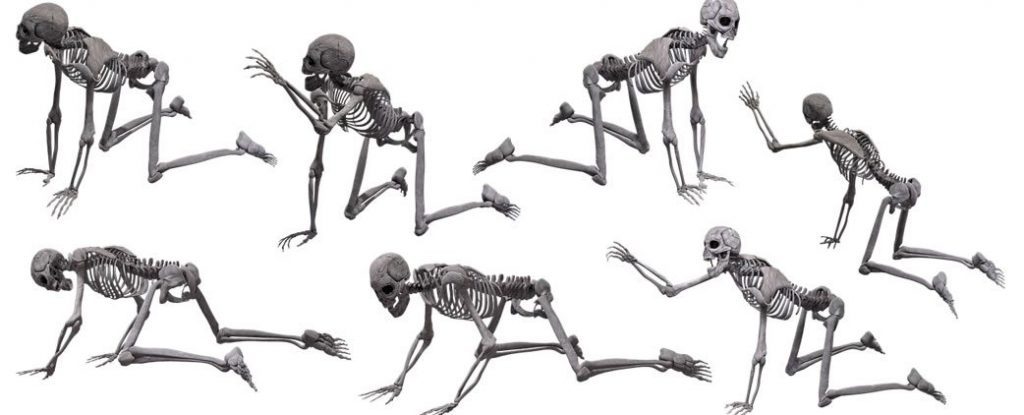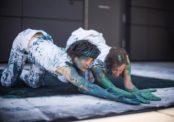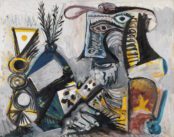[dropcap style=”fontsize:100px;color:#992211;”]I[/dropcap]n 1987, Michael Jackson performed a mind-boggling dance move in his new music video, “Smooth Criminal”. He leaned 45° forward while keeping his spine straight, using only his feet to prevent him from falling. Those who believed that special effects had been used were shocked to see him perform the move in live concerts all over the world. For generations since, dancers have tried to emulate his movements and have developed the dance form he introduced into a new challenge to our understanding of spinal biomechanics. But did MJ really achieve the impossible?
When the human body stands erect, its centre of gravity (COG) lies in front of the second sacral vertebra. Studies of biomechanics and kinesiology suggest that, as we bend forward with a straight torso, keeping our hip joints as the fulcrum, the erector spinae muscles act like cables to support the suspended spinal column during the forward shift of the COG, preventing the body from falling forward. However, when the fulcrum for forward bending is shifted to the ankle joints, the erector spinae lose their ability to maintain the COG, and strain is shifted to the Achilles tendon (Fig. B). This allows for a very limited degree of forward bending from the ankle joints, while keeping a stiff straight posture—unless you are Michael Jackson. Most trained dancers with strong core strength will reach a maximum of 25° to 30° of forward bending while performing this action. MJ pulled off a gravity-defying 45° move that seems unearthly to any witness. Fans have tried to copy this move and failed, often injuring themselves in their endeavours.

A: The ‘antigravity tilt’ in comparison to the normal limit of a human tilt. B: Shift of the fulcrum from the sacrum to the Achilles tendon in the antigravity tilt. Credit: Manjul Tripathi.
As nice as it would be to believe that MJ broke the relationship between physiology and physics, a patent registered under his name shows that the move was accomplished with a clever invention. Along with fellow inventors, MJ developed a special shoe that had a slot in the heel. The triangular slot could engage a hitch member (a metallic peg, which emerged from the stage floor at just the right time), allowing the dancer to obtain the right amount of extra support to be able to lean forward beyond physiological limits (Fig. A). The move was an illusionary trick. But even with specially designed footwear and the support of the hitch member, the move is incredibly hard to pull off, requiring athletic core strength from strengthened spinal muscles and lower-limb antigravity muscles.
Trick or not, new forms of dancing inspired by MJ have begun to challenge our understanding of the modes and mechanisms of spinal injury. Throughout the world dancers have tried to jump higher, stretch farther, and turn faster than ever before. Hip-hop and particularly its offshoot, b-boying/b-girling, are two styles that include significant elements of acrobatics, resulting in high stresses on the spinal column. The rapid rise in popularity of dance as an art and exercise is bound to produce new forms of injury that may perplex the neurosurgeon. The situation will become more complicated when a dancer who has received a surgical construct for fixation wants to continue dancing. It remains to be seen how surgical implants will hold up to the stresses of dance. While many new questions need answering, what is certain is that all this is owed to the ever-fresh inventiveness and style of The King of Pop.
Source: Journal of Neurosurgery – published online May 22, 2018; DOI: 10.3171/2018.2.SPINE171443

Naila Scargill is the publisher and editor of horror journal Exquisite Terror. Holding a broad editorial background, she has worked with an eclectic variety of content, ranging from film and the counterculture, to political news and finance.



















![L'Esprit comique [Der komische Geist], René Magritte, 1928. Courtesy Sammlung Ulla und Heiner Pietzsch, Berlin © 2025, ProLitteris, Zurich Photo Credit: Jochen Littkemann, Berlin](https://b276103.smushcdn.com/276103/wp-content/uploads/2025/07/ew11_0098489_2025-05-12_web-140x174.jpg?lossy=1&strip=0&webp=1)


Carlotta Tocci Erica Bront
THe grandeur of human body !
Erica Bront After a little research I found out Michael used a special type of shoe to preform this move. He created the shoes with the partnership of a special shoemaker.
https://www.menshealth.com/entertainment/a20870996/doctors-break-down-michael-jacksons-gravity-defying-dance-moves/